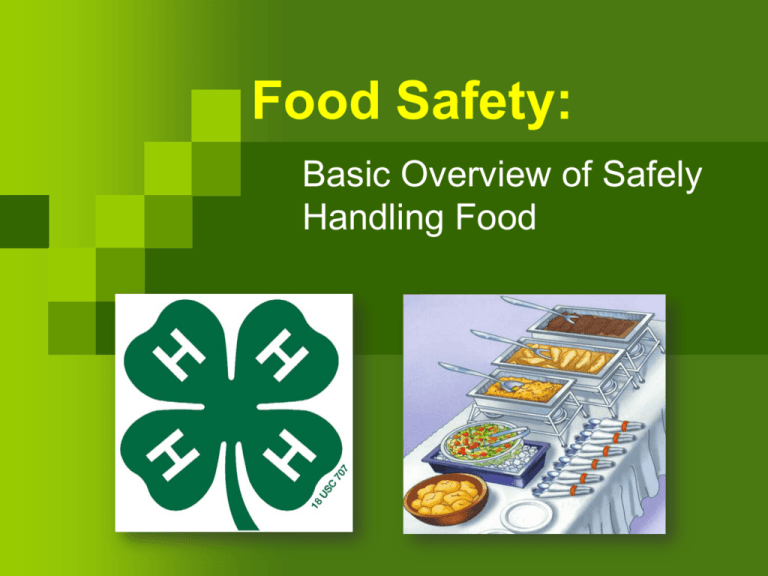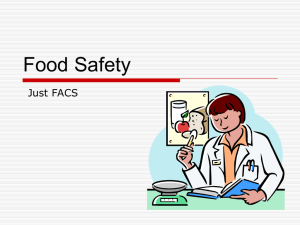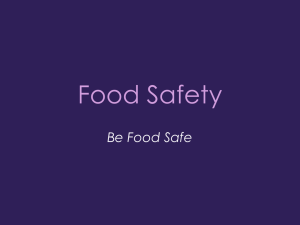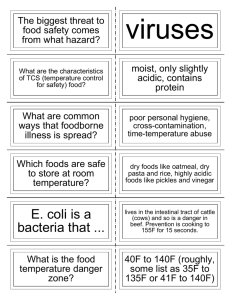Food Safety - UC Agriculture and Natural Resources
advertisement

Food Safety: Basic Overview of Safely Handling Food Food Safety Training The Nevada County Environmental Health Department requires that one person be in the food booth at any given time with a working knowledge of safe food handling practices. If you are planning on serving food as part of a 4-H activity, event or fundraiser, the food preparation and service must be in compliance with all local (city and county) health department rules and state laws. How do we “Make it Safe?” and “Serve it Safe?” Food can become contaminated and cause foodborne illnesses three different ways: Biological - bacteria, viruses, mold, parasites, and naturally poisonous plants, fish, and shellfish Chemical – cleaning solutions, insecticides, industrial processing chemicals, agricultural chemicals, and pesticides and pest bait Physical – pieces from food packaging, glass fragments, pieces from machinery or equipment, dust and dirt, insects, hair, fingernails, toothpicks, adhesive bandages, leaves & stalks from vegetables All people are at risk for food borne illness. Some groups are at a higher risk because they have a weakened immune system. Infants and young children Elderly people Pregnant women People with diabetes Common Agents of Contamination Bacteria grow best when the following conditions are met: Food Acidity Time Temperature Oxygen Moisture AKA FATTOM Food: Most bacteria prefer foods that are high in protein, cut fruits and vegetables, and high moisture content. Acidity: Acidic foods such as lemon juice and vinegar make it difficult for most bacterial to multiply and are useful for preserving foods. Time: Not much time is needed for bacteria to grow to a level that causes foodborne illness; they grow by dividing; one bacterium splits in two so two becomes four, four become eight, etc Temperature: Bacteria will multiply most rapidly at temperatures between 40°F and 140°F = DANGER ZONE! Oxygen: Some bacteria need oxygen to multiple while others can thrive without it. And then some bacteria can live with or without it. Moisture: Pathogenic bacteria need moisture to stay alive and cannot multiply in dried foods. However, add water to that dried food and you provide the perfect conditions for bacterial growth. Bacteria are everywhere, including potentially harmful bacteria, unless something is sterilized. The bacteria can make you ill when they are in an environment where they can multiply. Home grown produce Organic produce Commercial produce Raw meat or poultry Unwashed hands Insects How is Pathogenic Bacteria spread causing contamination? Raw food People Pest & pets Air & dust Water Soil Food waste Depending on the type of agent responsible, you can become ill as soon as one-half hour after eating the contaminated food or as long as 6 weeks after eating it. 4 Steps to Food Safety Clean Separate Cook Chill Step 1: Clean Hands Utensils Surfaces Fruits &Vegetables Do NOT wash or rinse meat and poultry as this could spread bacteria to other foods Good Personal Hygiene Requires: Wash hands Clean clothing Tie hair back or wear hat or hair net ***No smoking and/or eating in food preparation and washing areas No jewelry Step 2: Separate - How do you prevent contamination? Raw, cooked, ready-to-eat, and potentially hazardous foods are kept apart at all times (i.e., shopping, preparing, storing). Store cooked and ready-to-eat foods above raw foods. Clean and sanitize utensils, plates, and surfaces after working with raw foods and before working with ready-to-eat foods. Keep foods covered until use. Use utensils to move food. Avoid touching foods with bare hands. Wear disposable gloves. Wash all raw vegetables, fruit, and rice before use. Maintain food areas and food equipment in good condition. Sick people should not prepare, cook, or serve food. Follow strict hygiene habits. Use Different Cutting Boards Use one cutting board for fresh produce Use a separate one for raw mean, poultry, and seafood. Step 3: Cook Cook foods to a safe temperature to kill microorganisms. The ONLY way to know if food has been cooked to a safe internal temperature is to use a food thermometer! Calibrate routinely, after measuring extremely hot or cold temperatures, and when dropped. Appearance, odor and taste cannot accurately determine if food is safe. Illness-causing agents that contaminate food, including bacteria, generally do not create any noticeable changes in food as they multiply. Temperature Control: This will help control conditions that promote bacterial growth Keep cold food cold, ideally at 40°F or below. Keep hot food hot, at 140°F or above. When cooking food in a microwave oven: Cook to 165°F; Cover, rotate, and stir Allow to stand after cooking Temperature Control While Cooking: To make sure all parts of the food is heated to safe levels: Cut large roasts and poultry into small portions. Cook stuffing separate. Stir stews and casseroles during cooking. Be extra careful when cooking with Microwave ovens - they cause cool spots often. Step 4: Chill Chill (refrigerate) perishable foods promptly and defrost foods properly Causes of Foodborne Illness 4% Use of leftovers 7% Improper cleaning 7% Cross contamination 11% Contaminated raw food 12% Inadequate reheating 16% Improper hot storage 16% Inadequate cooking 20% Infected persons touching food 21% Time between preparing and serving 40% Improper cooling of foods Temperature Control While Cooling Hot Food: Hot food passes through the “danger zone” as it cools so you must cool promptly: Blast chiller, ice bath, or refrigerator Leave container cover open until food has cooled Use clean, cold container Use shallow trays and pans Stir periodically speeds up cooling process Remove cooked meats from their juices before cooling Cool in small amounts Cool foods from 140° to 40°F quickly. Temperature Control While Thawing Frozen Food: Many raw frozen items, such as meat and poultry should be completely thawed before cooking: Use thawing cabinet or refrigeration unit. Place on lowest shelf. Use microwave ovens if manufacturer’s instructions are followed carefully. Temperature Control While Reheating Food: Reheat foods to at least 165°F. Reheat gravies, sauces, and soups to a boil. Hot foods should be cooled and reheated only one time. Remove from refrigeration just before reheating and serving. What To Do With Cold Foods? Cold food should be kept on ice or in a cooler. Cut fruits and vegetables can grow bacteria – keep cold. Do not leave out of refrigeration more than 2 hours. Discard any remaining food that has been at room temperature for more than 2 hours, maximum! Recommended Refrigerator & Freezer Temperatures Set refrigerator at 33° to 40°F Set freezer at 0°F or less. Use thermometers in and check weekly This information is just the tip of the iceberg for handling food safely. For further information, contact your local health department or logon to http://www.foodprotection.org. Internet Guide to Food Safety Food Safety and Inspection Service: www.fsis.usda.gov Government Food Safety Information: www.foodsafety.gov FDA: www.cfsan.fda.gov CDC: www.cdc.gov/foodsafety Partnership for Food Safety Education: www.fightbac.org UC Food Safety Website: http://groups.ucanr.org/ucfoodsafety/ Food Safe: http://foodsafe.ucdavis.edu Sea Grant (Seafood Safety): http://seafood.ucdavis.edu






